 |
| Bryher and Tresco |
 |
| The 'Bar' connecting St Agnes and Gugh |
 |
| Manx Shearwater |
 |
| Tresco Abbey Gardens |
 |
| Common Dolphin |
 |
| Rugged Bryher |
 |
| Lapland Bunting |
 |
| Golden Pheasant |
 |
| 2014 Team! |
 |
| Scilly Sunset |
Greetings Interweb! I have a strange mind. No stranger than anyone else’s, I suspect, but strange enough to entertain me with musings from time to time. I wrote some of these musings down, and they appeared to entertain a few other folks too. So I thought there should be somewhere for them to hang out together. A book seemed woefully indulgent; a diary too personal. So the blog was born. It seemed cheaper than getting proper therapy.
 |
| Bryher and Tresco |
 |
| The 'Bar' connecting St Agnes and Gugh |
 |
| Manx Shearwater |
 |
| Tresco Abbey Gardens |
 |
| Common Dolphin |
 |
| Rugged Bryher |
 |
| Lapland Bunting |
 |
| Golden Pheasant |
 |
| 2014 Team! |
 |
| Scilly Sunset |